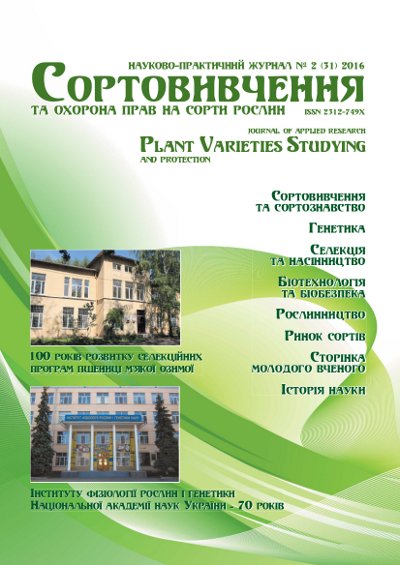Morphological features of leaves in climbing roses varieties of the genus Rosa L.
DOI:
https://doi.org/10.21498/2518-1017.2(31).2016.70318Keywords:
climbing roses, variety, compound leaf, leaf blade, biometric characteristics, decorative valueAbstract
Purpose. To study biometric characteristics of climbing roses leaves (length of compound leaf, the number of leaf blades, total leaf area and leaf blade area) and select the best varieties on this base. Methods. General biological (biometric) study and statistical evaluation. Results. As follows from the morphological analysis, a significant leaf size variation in the studied varieties of climbing roses was revealed. The leaf size in such varieties as ‘Kahovka’, ‘Flammentanz’, ‘Krasnyi Maiak’ was the largest, in ‘New Dawn’ and ‘Krymskoe Solnyshko’ – the smallest one. Based on the leaf biometric study of 9 varieties of climbing roses, the authors defined that ‘Flammentanz’, ‘Krasnyi Maiak’, ‘Kahovka’ varieties had the highest values of leaf parameters. The ‘Veilchenblau’ variety differed significantly from the other studied samples by the form and color of leaves that had a positive impact on its decorative value. Data obtained allowed to select varieties that can be used in landscaping not only because of flower decorative characteristics, but also due to attractive leaf appearance, as well as varieties for application in breeding programs related to this trait. Conclusions. Biometric characteristics of climbing roses leaves (length of compound leaf, the number of leaf blades, total leaf area and leaf blade area) were studied, and in compliance with the results the best varieties were selected that can be recommended for use in gardening and breeding.
Downloads
References
Khrzhanovskiy, V. G. (1958). Rozy. Filogeniya i sistematika. Spontannye vidy Evropeyskoy chasti SSSR, Kryma i Kavkaza. Opyt i perspektivy ispol’zovaniya [Roses. Race development and taxonomy. Spontaneous species of the European part of the USSR, Crimea and the Caucasus]. Moscov: Sovetskaya nauka [in Russian].
Yuzepchuk, S. V. (1941). Rod Roza (shipovnik) Rosa L.; Rod Khul’temiya – Hultemia Dumort; rod Khul’temoza – Hultemosa Juz. [The genus Rosa (wild rose) – Rosa L.; the genus Hultemia Dumort; the genus Hultemosa Juz.]. In Flora SSSR [Flora USSR] (Vol. 10, pp. 431–508). Moscow; Leningrad: Izd-vo AN SSSR. [in Russian]
Young, M. A., & Schorr, Ph. (Eds.). (2007). Modern Roses–12: The Comprehensive List of Roses in Cultivation or of Historical or Botanical Importance. Shreveport: The American Rose Society.
Doiko, N. M. (2005). Biolohichni osnovy introduktsii vytkykh derevnykh roslyn u Pravoberezhnomu Lisostepu Ukrainy [Biological basis of introduction of climbing tree plants in the Right-Bank Steppe of Ukraine]. (Extended Abstract of Cand. Sci. Diss.). Kyiv. [in Ukrainian]
Rubtsova, O. L. (2011). Rid Rosa L. v Ukraini: istoriia, napriamy doslidzhen, dosiahnennia ta perspektyvy [The genus Rosa L. in Ukraine]. (Doctor’s Sci. Diss.). Kyiv. [in Ukrainian]
Biryuleva, E. G., Klimenko, Z. K., & Chelombit, A. P. (2009). Anatomo-morfologicheskie osobennosti listovoy plastinki vidov i form roda Rosa L. v usloviyakh Prisivash’ya Kryma [Anatomo-morphological peculiarities of leaf blade of species and forms of the genus Rosa L. in conditions of Crimea Prisivashye]. Visnyk Kyivskoho natsionalnoho universytetu im. Tarasa Shevchenka. Seriia: Introduktsiia ta zberezhennia roslynnoho riznomanittia [Bulletin of Taras Shevchenko National University of Kyiv. Series: Introduction and conservation of plant diversity], 25–27, 32–33. [in Ukrainian]
Bilous, V. I. (2001). Sadovo-parkove mystetstvo. Korotka istoriia rozvytku ta metody stvorennia khudozhnikh sadiv [The garden art. Short story of the development and art garden design methods]. Kyiv: Naukovyi svit. [in Ukrainian]
Rubtsov, L. I. (1977). Derev’ya i kustarniki v landshaftnoy arkhitekture [Trees and shrubs in landscape architecture]. Kyiv: Naukova dumka. [in Russian]
Guidelines for the conduct of tests for distinctness, uniformity and stability of Rose (Rosa L.) (TG/11/8 Rev, UPOV). Retrieved from www.upov.int/edocs/tgdocs/en/tg011.pdf
Downloads
Published
How to Cite
Issue
Section
License
Copyright (c) 2016 Ukrainian Institute for Plant Variety Examination

This work is licensed under a Creative Commons Attribution-ShareAlike 4.0 International License.
Starting in 2022, the copyright to the publication remains with the authors
Our journal abides by the CREATIVE COMMONS copyright rights and permissions for open access journals.
Authors, who are published in this journal, agree to the following conditions:
- The authors reserve the right to authorship of the work and pass the first publication right of this work to the journal under the terms of a Creative Commons Attribution License, which allows others to freely distribute the published research with the obligatory reference to the authors of the original work and the first publication of the work in this journal.
- The authors have the right to conclude separate supplement agreements that relate to non-exclusive work distribution in the form in which it has been published by the journal (for example, to upload the work to the online storage of the journal or publish it as part of a monograph), provided that the reference to the first publication of the work in this journal is included.

























 Ukrainian Institute for Plant Varieties Examination
Ukrainian Institute for Plant Varieties Examination  Селекційно-генетичний інститут
Селекційно-генетичний інститут Institute of Plant Physiology and Genetics of the National Academy of Sciences of Ukraine
Institute of Plant Physiology and Genetics of the National Academy of Sciences of Ukraine
 The National Academy of Agrarian Sciences of Ukraine
The National Academy of Agrarian Sciences of Ukraine